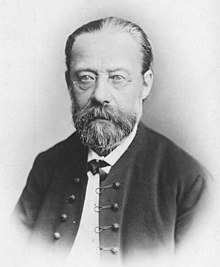 The RPYO presents its Annual Side-by-Side Concert with the RPO on Sunday, March 4 at 3 PM in Kodak Hall
The RPYO presents its Annual Side-by-Side Concert with the RPO on Sunday, March 4 at 3 PM in Kodak HallDavid Harman, Conductor
Sunday, March 4, RPO musicians will share music stands with the talented student musicians of the Rochester Philharmonic Youth Orchestra for a performance of two renowned orchestral works by famous composers of Czech origin in a concert called “Moldau & Mahler.”
 The program will feature Bedřich Smetana’s (left) symphonic poem The Moldau, which traces the journey of the Moldau River as it flows through the Bohemian countryside and into the city of Prague towards its confluence with the Elba River. A highly innovative work for the 1870s, it is rich with orchestral colors, evocations of rustic Bohemian life, and Slavic folklore, and portrays nature as both a benign and tumultuous force.
The program will feature Bedřich Smetana’s (left) symphonic poem The Moldau, which traces the journey of the Moldau River as it flows through the Bohemian countryside and into the city of Prague towards its confluence with the Elba River. A highly innovative work for the 1870s, it is rich with orchestral colors, evocations of rustic Bohemian life, and Slavic folklore, and portrays nature as both a benign and tumultuous force.
Forty years younger than Smetana, Gustav Mahler (right) lived much of his life in Vienna but never forgot his own Czech origins. His symphonies are rich with streets sounds, tunes, rhythms, and emotional experiences recalled from his childhood. Some of these are included in the big, intense final movement of his first symphony that the RPYO and RPO will also perform together, a movement that Mahler labeled “stormy” and “vehement,” referring perhaps to both natural forces and human emotions.
The first half of the concert will feature RPYO Concerto Competition winners Matthew DeCross, a 12th grade marimbist from Pittsford Sutherland High School; Erica Klafehn, a 12th grade violist from Penfield High School; and Hayley Miller, an 11th grade flutist from Canandaigua Academy. Matt will play a lively movement from the popular Marimba Concerto No. 1 by Brazilian composer Ney Rosauro. The mood will shift dramatically as Erica performs the deeply mournful Trauermusik written in 1936 by the German composer Hindemith, who wrote this work not only in grief for the death of the British King George V but also for the traumas he was witnessing in Germany under the Nazis. A movement from Mozart’s first Flute Concerto, to be performed by Hayley, will be a delightful restorative tonic, as only Mozart can be. To finish the concert’s first half, the entire RPYO will come together for Argentine composer Arturo Ginastera’s musical portrait of scenes from the Argentine countryside.
 March 4th at 3:00 PM, Kodak Hall at Eastman Theatre. Tickets are $12.00 for Adults and $8.00 for Students and Seniors and can be purchased from RPYO musicians, from the Eastman Theatre Box Office on 433 Main Street in the East Wing of the Eastman School of Music, by telephone at 454-2100, online, or by calling the RPYO at 454-7311 x224.
March 4th at 3:00 PM, Kodak Hall at Eastman Theatre. Tickets are $12.00 for Adults and $8.00 for Students and Seniors and can be purchased from RPYO musicians, from the Eastman Theatre Box Office on 433 Main Street in the East Wing of the Eastman School of Music, by telephone at 454-2100, online, or by calling the RPYO at 454-7311 x224.We invite you to go to rpyo.org to learn more about the RPYO, including information on our Spring Auditions for new members, which will take place at the end of March.








 Violinist
Violinist 
